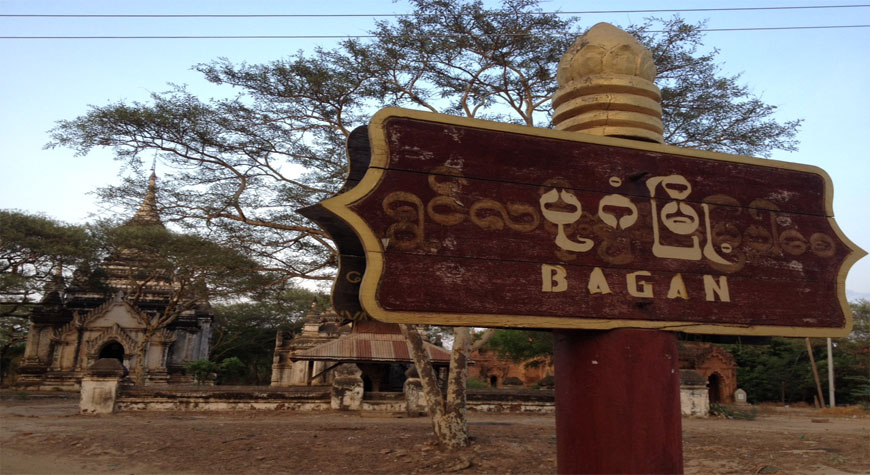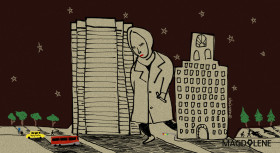Seated inside a propeller plane, my bird’s eye view of Bagan gave me a prelude of the surreal experience to come. As the ATR-series aircraft began to descend, the barren landscape revealed dozens of terracotta temples with pointed roofs springing up like giant mushrooms.
Bagan, which lies in Myanmar’s dry central zones, is home to a colony of some 4,000 Buddhist temples and pagodas scattered throughout an area almost half the size of Kuala Lumpur city. About 1,200 years old, this ancient city offers a curios site for archeology aficionado and amateur photographer (that includes selfies with gloating Facebook photos) like me.
I visited Bagan in mid-May, at the height of Myanmar’s dry season when the punishing temperature could hit 41 degrees Celsius and the blazing sun seemed perpetually hovering over your head. Armed with a pair of oversized UV-proofed prescription sunglasses and made-in-China fedora hat, however, I was determined to beat the heat and to explore the ancient wonder of Bagan undauntedly.
“Let’s take the bicycles!” declared my travelling companion, Florence, an energetic Malaysian lady with a sharp mind of a tax auditor. The hotel staff offered a choice between rickety bicycles and handsome-looking electric bikes (no pedaling, push the button and off you go).
And, of course, being intrepid travelers, we went for the conventional push bikes, a decision I severely regretted five minutes later. (Panting, panting, and panting)
Bagan’s pre-afternoon heat proved too much for us, savvy travelers from the tropical South East Asian cities who are used to air-conditioned rooms and mega malls. Plus my idea of cycling is confined to riding stationary bikes at the gym.
With the heat reaching its peak by the minute, we were in danger of suffering from sunstroke and dehydration. If we didn’t change our game plan, we’d have to take our selfies from hospital beds.
There’s another important consideration: all visitors in Myanmar must enter the holy sites barefoot, stripped of even socks. Not willing to let the sun-baked tiles barbecued our feet, we decided to return to the hotel.
Sunset and Sunrise
“I’m more than happy to sleep in the hotel in the afternoon and visit the main temples when the sun’s not out,” Florence said over a glass of cold drink during our first lunch, eyes laser-like.
I couldn’t agree more: photos of sunrise and sunset are major hits on Facebook. Besides, I didn't want to be ‘templed out’, a fatigued mental condition caused by squeezing too many temple visits in a trip.
So on our first sunset view we took a rented cab to Shwensandaw Pagoda, a five-tier monument with a huge stupa – a bell-shaped monument – perched on its fifth terrace. Our driver told us it’s a place to be for sunset viewing. No kidding, the white colored brick pagoda was already swarmed with tourists when we arrived.
Stairs with a 60-degree slope taunted us. Tourists were climbing up the seemingly impassable stairs, occasionally screaming ‘ouch!’, their hands or feet singed by the iron railing or the stairs surface that had been baked in the sun all day.
At the bottom of the stairs I looked up at the towering stupa, where some tourists were sitting, legs dangling, on the ledge.
“How in the world did they get up there?” I wondered, then began my ouch-filled climb up the steps.
But I managed to reach the top, where I could see a barren landscape dotted with various shapes and sizes of pagodas and temples, including a couple of pyramid-like towers. It was like a setting of some epic fantasy movies about the East and Buddhism.

In a far distant, I could see the silhouette of long rectangular hills like a row of over-extended tables. We got some decent pictures of the sunset. Unfortunately, seams of clouds partially covered the burning orange ball, and the noise of the jostling crowd was a little bit overwhelming.
We avoided the crowd during sunrise the next day. Just after 5 a.m., we were on a slightly bumpy ride, driving past countless number of temples on either side of the empty road. The dark blue sky was turning pale by the second as we reached our destination, Phya That Da pagoda.
The lesser-known pagoda is a red brick monument with a step pyramidal style. Realizing we’ve miscalculated the timing, we rushed to find the stairs that led us to the top terrace, but it was bright daylight by the time we reached the summit.
Our disappointment dissipated the moment we saw a panoramic view of Bagan with its temples and pagodas. Morning birds were chirping harmoniously, and the only other sound came from a farmer clearing a field in a distance – presumably giving words of encouragement to two sturdy white oxen.
A bright orange ball appeared on the east horizon and the gentle morning breeze soothed us. With no one else at the temple, it was dream-like.
Bagan at Night
I came to Bagan from Yangon where I visited the city’s main pagoda, Shwedagon at night. The lights gave a dramatic view of the towering golden pagoda and it was solid gold everywhere as I walked amongst locals dressed in longyi sarongs and saffron-robed monks.
Some of Bagan’s temples offer similar dramatic scenes. The best way is to see the temples at night, taking the favorite route, a long stretch connecting Old Bagan to Nyang U market.
The map supplied by the hotel had warned that “nightlife in Bagan doesn't exist”, so what better way to spend the evening than snapping some pictures of Bagan temples showered in light?
As for the ride, we’d gotten smarter this time and chose the electric bikes. Just pushed the key in, turned the right knob and off we went, with a cool breeze in our face, and without panting.
About Tomi Soetjipto
Tomi is a former journalist at Thomson Reuters, Al Jazeera English and BBC Indonesia. He now works for an international development organization in Jakarta.






-thumb.jpg)

Comments